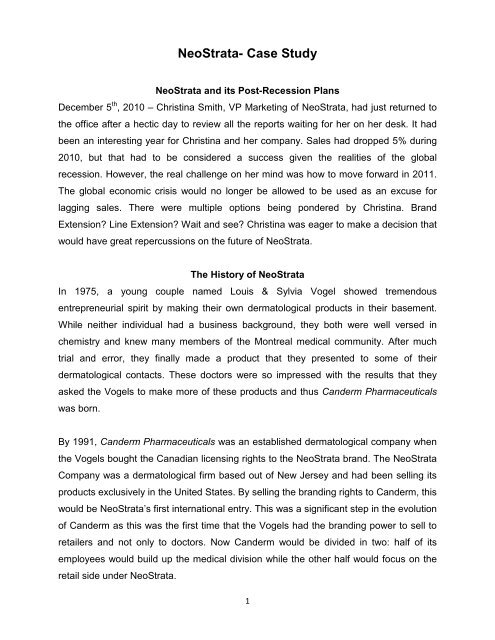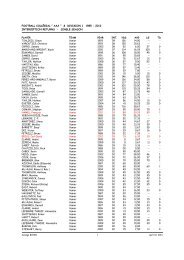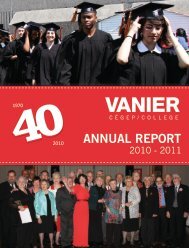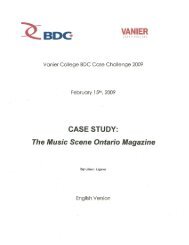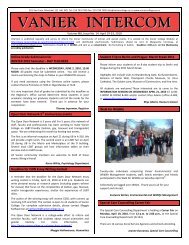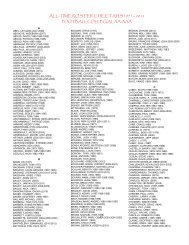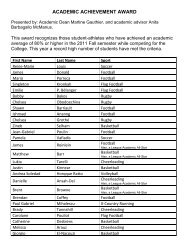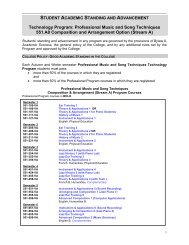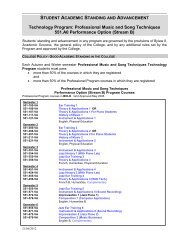NeoStrata- Case Study - Vanier College
NeoStrata- Case Study - Vanier College
NeoStrata- Case Study - Vanier College
You also want an ePaper? Increase the reach of your titles
YUMPU automatically turns print PDFs into web optimized ePapers that Google loves.
<strong>NeoStrata</strong>- <strong>Case</strong> <strong>Study</strong><br />
<strong>NeoStrata</strong> and its Post-Recession Plans<br />
December 5 th , 2010 – Christina Smith, VP Marketing of <strong>NeoStrata</strong>, had just returned to<br />
the office after a hectic day to review all the reports waiting for her on her desk. It had<br />
been an interesting year for Christina and her company. Sales had dropped 5% during<br />
2010, but that had to be considered a success given the realities of the global<br />
recession. However, the real challenge on her mind was how to move forward in 2011.<br />
The global economic crisis would no longer be allowed to be used as an excuse for<br />
lagging sales. There were multiple options being pondered by Christina. Brand<br />
Extension? Line Extension? Wait and see? Christina was eager to make a decision that<br />
would have great repercussions on the future of <strong>NeoStrata</strong>.<br />
The History of <strong>NeoStrata</strong><br />
In 1975, a young couple named Louis & Sylvia Vogel showed tremendous<br />
entrepreneurial spirit by making their own dermatological products in their basement.<br />
While neither individual had a business background, they both were well versed in<br />
chemistry and knew many members of the Montreal medical community. After much<br />
trial and error, they finally made a product that they presented to some of their<br />
dermatological contacts. These doctors were so impressed with the results that they<br />
asked the Vogels to make more of these products and thus Canderm Pharmaceuticals<br />
was born.<br />
By 1991, Canderm Pharmaceuticals was an established dermatological company when<br />
the Vogels bought the Canadian licensing rights to the <strong>NeoStrata</strong> brand. The <strong>NeoStrata</strong><br />
Company was a dermatological firm based out of New Jersey and had been selling its<br />
products exclusively in the United States. By selling the branding rights to Canderm, this<br />
would be <strong>NeoStrata</strong>’s first international entry. This was a significant step in the evolution<br />
of Canderm as this was the first time that the Vogels had the branding power to sell to<br />
retailers and not only to doctors. Now Canderm would be divided in two: half of its<br />
employees would build up the medical division while the other half would focus on the<br />
retail side under <strong>NeoStrata</strong>.<br />
1
From 1992 to 2007, <strong>NeoStrata</strong> slowly build up its Canadian presence through word of<br />
mouth, product development and a reputation for skin care treatments that simply<br />
worked. In 2008, <strong>NeoStrata</strong> Wrinkle Repair was introduced. This product offered up to a<br />
76% reduction in the length of wrinkles. Because of its clinical and critical success, it<br />
won numerous awards from well respected beauty magazines such as Chatelaine and<br />
from retailers such as Shoppers Drug Market. Through the success of this one SKU<br />
(Stock-keeping unit) alone, sales for <strong>NeoStrata</strong> increased by 39%. The biggest<br />
challenge in 2008 was simply keeping up with customer demand.<br />
By the end of 2010, things had drastically changed. Wrinkle Repair, while still selling<br />
well, was no longer the “hot” item on the shelf. Overall sales for the brand were no<br />
longer at 2008 levels. In addition, there was no product in the R&D pipeline as<br />
innovative as Wrinkle Repair. The question for Christina was “How does <strong>NeoStrata</strong><br />
recapture the 2008 magic”? Due to licensing agreements, Christina is only responsible<br />
for <strong>NeoStrata</strong> sales in Canada.<br />
<strong>NeoStrata</strong>’s Products<br />
<strong>NeoStrata</strong> offers a full line of skin care products at the retail level. Among the product<br />
categories are acne care, cleansing, exfoliating, multi anti-aging, anti-wrinkle, lightening,<br />
radiance, moisturizing, firming and sun care. From a pure product perspective, there’s<br />
not much that can be done to improve or add new products. Health Canada puts a limit<br />
on the number of active ingredients allowed in products at the retail level. Active<br />
ingredients enable skin products to perform specific functions. For example, glycolic<br />
acid is the main active ingredient to exfoliate the skin. Most of <strong>NeoStrata</strong>’s products are<br />
already on the upper to maximum limit allowed for active ingredients. Because<br />
<strong>NeoStrata</strong> already carries 10 categories that each has multiple SKUs, there isn’t a clear<br />
hole in its product portfolio to fill. Simply put, there isn’t much that can be done to<br />
improve <strong>NeoStrata</strong>’s product mix.<br />
From a competitive standpoint, <strong>NeoStrata</strong>’s products are the most effective on the<br />
market as they contain the most allocated ingredients available. The majority of their<br />
products are backed by independent clinical trials which only re-emphasize the<br />
products’ effectiveness. All of <strong>NeoStrata</strong>’s products are fragrance free to distinguish the<br />
2
and from competitors that would choose style over substance. Adding odors won’t<br />
change the quality of the product, so top management was concerned that doing so<br />
would be inconsistent with <strong>NeoStrata</strong>’s brand image that promoted efficacy.<br />
Unfortunately, many users prefer skin care products that have a distinct scent so many<br />
consumers won’t purchase <strong>NeoStrata</strong> products for this reason.<br />
The <strong>NeoStrata</strong> Brand<br />
The <strong>NeoStrata</strong> brand is based on three very simple principles: simple, clear, and<br />
effective. While other companies may try to impress or distract their audiences with<br />
flashy packaging while hiding their key ingredients, <strong>NeoStrata</strong> keeps everything simple<br />
and transparent. The ideology behind the brand is the following: “If our products work,<br />
we should have nothing to hide”. Packaging and all communication pieces are very<br />
conservative in nature in order to stay consistent with those three principles.<br />
<strong>NeoStrata</strong>’s core brand positioning is transparency and science. By focusing on<br />
ingredients and efficacy in a transparent manner, <strong>NeoStrata</strong> can compare and contrast<br />
products and demonstrate why its own are superior. The brand definitely appeals to the<br />
consumer’s rational side rather than their emotional one.<br />
While this tactic is effective with older customers (50+), it’s far less effective with those<br />
less than 50 years of age. Older consumers are more conservative and practical. They<br />
prefer buying products that work rather than brands that offer empty promises. More<br />
importantly, they often want to know how a certain product works. Younger consumers<br />
are more brand conscious. As such, it’s more important for them to buy a cool brand<br />
rather than reap the benefits of a product. This makes it very difficult for <strong>NeoStrata</strong> to<br />
capture a younger target market who simply don’t care that some of their products<br />
contain 10% glycolic acid. It’s more important for this target market to feel better, rather<br />
than know why their skin will be healthier.<br />
Overall that puts <strong>NeoStrata</strong> on shaky ground. Its main consumers are baby boomers<br />
and senior citizens. In the short-term, everything is fine as sales are steady. In the longterm,<br />
there will be no growth and sales will eventually decline if <strong>NeoStrata</strong> fails to reach<br />
a younger audience.<br />
3
Competitive Landscape<br />
In beauty care, there are three main segments of skin care products: mass, luxury and<br />
active. The most basic level is “mass”. These products contain ingredients with no<br />
practical benefits. They simply smell and feel good on your skin; common brands<br />
include: L’Oreal Paris, Maybelline and Garnier. Their brand communication strategies all<br />
focus on images of models and fashion trends.<br />
The “luxury” category includes brands like Lancome, and Biotherm. In reality, they are<br />
simply higher end “mass” products with more expensive packaging and higher price<br />
points. The products themselves are fairly similar, but the advertising behind them make<br />
them appear higher quality than they are. The products, chemically speaking, are to be<br />
considered higher quality than those in the mass category.<br />
The final category is “active”. All these brands contain active ingredients that can affect<br />
the skin at the cellular level. For example, most exfoliating products in the active<br />
category contain glycolic acid which is a small a-hydroxy acid with a pH as low as 0.6.<br />
Once applied to the skin, glycolic acid reacts with the upper layer of the epidermis,<br />
weakening the binding properties of the lipids that hold the dead skin cells together.<br />
This allows the stratum corneum to be exfoliated, exposing live skin cells.<br />
Popular brands in this category include: Vichy, La-Roche Posay, Bioderma, Clarins and<br />
Avène. Vichy, owned by L’Oreal, positions themselves as the up-scale active brand by<br />
using celebrities to endorse their products. La-Roche Posay, also owned by L’Oreal,<br />
has an approach similar to <strong>NeoStrata</strong>’s; they both focus on ingredients rather than<br />
aesthetics. However, <strong>NeoStrata</strong> focuses more on medical benefits while L’Oreal<br />
emphasizes beauty. Bioderma should be considered a lower-end La-Roche Posay.<br />
Clarins is the active brand that most resembles the brands in the “luxury” category.<br />
Finally, Avène puts its European heritage at the forefront of their campaigns.<br />
While <strong>NeoStrata</strong> has its own position, it’s very difficult to make the brand stand out due<br />
its lack of capital. Many of its main competitors are owned by L’Oreal and Johnson and<br />
Johnson. Both firms have access to better distribution channels, more financial capital<br />
and recruit the best talent. To put it into perspective, <strong>NeoStrata</strong>’s sales are smaller than<br />
4
L’Oreal Canada’s marketing budget. Maximizing <strong>NeoStrata</strong>’s resources to maintain a<br />
competitive edge is thus very difficult and essential to survival.<br />
Pricing & Distribution<br />
Despite having products that are among the best, if not the best, in the market,<br />
<strong>NeoStrata</strong>’s products aren’t priced to reflect this high quality. Certain <strong>NeoStrata</strong><br />
products were 10-50% less expensive than competitor’s products. <strong>NeoStrata</strong>’s weak<br />
brand equity prohibits it from raising prices. In this industry, the brand dictates price, not<br />
product quality. Furthermore, management felt raising prices was a risky proposition<br />
that would anger current consumers. No previous attempts to raise price points have<br />
ever been made.<br />
Drugstores are the main distributors of <strong>NeoStrata</strong> products. More than half of its total<br />
sales come from Shoppers Drug Mart (Pharmaprix). Because of this, all promotional,<br />
pricing and product decisions are communicated to Shoppers Drug Mart before<br />
launching. Other distributors include Familiprix, Jean Coutu and London Drugs. Shelf-<br />
space is extremely competitive, so gaining more space is extremely unlikely. Any new<br />
product launch or line extension must take a current SKU off the shelf. Given<br />
<strong>NeoStrata</strong>’s rather small size, it’s impressive how much shelf-space it actually owns.<br />
<strong>NeoStrata</strong> does not offer direct distribution. There is a very limited online presence on<br />
www.well.ca, which is an online personal care website. Some consideration was given<br />
to begin selling online through <strong>NeoStrata</strong>’s website, but the operations department<br />
vetoed the idea stating that production issues as well as high costs made this an<br />
unprofitable venture.<br />
Promotional Mix<br />
With a total national marketing budget of $1,000,000, the VP marketing has her work<br />
cut out for her. Optimizing her advertising budget is one of her priorities. Television and<br />
radio are simply too cost-prohibitive to use. Beauty magazines such as Chatelaine, Elle,<br />
Vita and More have been the main communication tool for <strong>NeoStrata</strong>. Those magazines<br />
have an older readership interested in beauty, making it a perfect fit for the brand.<br />
Approximately 75% of the budget went into this medium. The remaining 25% was split<br />
5
etween in-store promotions (10%), website (5%), events (5%) and contests (5%). That<br />
25% represents brand “maintenance” more than brand “promotion”, but lowering it is out<br />
of the question. Christina would love to create campaigns, but feels handicapped by a<br />
low budget and a simple brand.<br />
Packaging was another important element to consider. <strong>NeoStrata</strong>’s products have a<br />
pure white packaging with a small colored stripe representing the product category. This<br />
was originally done to stay consistent with <strong>NeoStrata</strong>’s “simple” and “clear” brand<br />
image. However the end-result is packaging that is frankly “boring”. To change<br />
packaging for the entire line would take a considerable investment (0.5-2% of the<br />
marketing budget) as it would necessitate changes in every other tool of the<br />
communication mix. Perhaps finding a middle ground is possible?<br />
Canadian Market<br />
The Canadian Market as a whole is very different. According to <strong>NeoStrata</strong>’s sales reps<br />
based on their own market research and experience, Quebecers seek what’s new and<br />
stylish, Ontarians seek value, while Western Canadians seek what’s practical. The<br />
larger issue is that <strong>NeoStrata</strong> deals with national retailers, so selling regional products is<br />
not feasible. Ironically, despite being headquartered in Montreal, <strong>NeoStrata</strong>’s brand is a<br />
better fit outside of Quebec . Ontario’s sales represent approximately 45% of<br />
<strong>NeoStrata</strong>’s sales. Is there an effective way to capture the attention of all the different<br />
provinces?<br />
The Future of <strong>NeoStrata</strong><br />
Christina had all the information she needed to make a decision, but it was now time to<br />
choose a direction. She understood that if she maintained the status quo for the next<br />
couple of years, her sales would likely be maintained at current levels. Eventually<br />
though, sales would decline. Something needed to be done.<br />
The idea of creating an entirely new brand to specifically target younger consumers had<br />
been discussed before. Christina felt that she could probably convince her president to<br />
6
invest an extra $250,000 into this particular project. While this had the biggest profit<br />
potential, it also had the highest likelihood of failure.<br />
Using the current <strong>NeoStrata</strong> brand to target younger consumers was also a viable<br />
option. However, there were clear concerns. Would it be possible to do so without<br />
alienating current customers?<br />
Finally, perhaps simply tweaking the brand was the correct direction. Perhaps only<br />
raising prices? Or changing packaging to appeal to a broader consumer base?<br />
On her immediate agenda was creating a detailed marketing plan that would properly<br />
segment the market, create the appropriate marketing mix, increase both the visibility<br />
and popularity of the brand, and position <strong>NeoStrata</strong> for success in the future.<br />
Your mandate is to present strategic marketing recommendations to the VP Marketing.<br />
Copyright 2011. This case was prepared by Kevin Gardner Gregory solely for the use of the <strong>Vanier</strong> <strong>Case</strong><br />
Competition. <strong>Case</strong>s are not intended to serve as endorsements, sources of primary data, or illustrations of<br />
effective or ineffective management. No reproduction of this case is permitted without the expressed written<br />
consent of the <strong>Vanier</strong> <strong>Case</strong> Competition Organizing Committee. For confidentiality reasons, some names and<br />
financials are fictional<br />
7
Exhibit 1:<br />
Canadian Population by Age & Gender in 2009<br />
Canada Male Female Canada Male Female<br />
Age group Persons (thousands) % of total of each group<br />
Total 33,739.90 16,732.50 17,007.40 100 100 100<br />
0 to 4 1,837.70 943.4 894.3 5.4 5.6 5.3<br />
5 to 9 1,799.30 925.7 873.6 5.3 5.5 5.1<br />
10 to 14 1,974.60 1,011.80 962.8 5.9 6 5.7<br />
15 to 19 2,252.10 1,153.30 1,098.80 6.7 6.9 6.5<br />
20 to 24 2,321.40 1,192.60 1,128.90 6.9 7.1 6.6<br />
25 to 29 2,347.90 1,185.60 1,162.30 7 7.1 6.8<br />
30 to 34 2,261.70 1,131.70 1,130.00 6.7 6.8 6.6<br />
35 to 39 2,303.00 1,160.60 1,142.40 6.8 6.9 6.7<br />
40 to 44 2,484.70 1,251.80 1,232.90 7.4 7.5 7.2<br />
45 to 49 2,790.10 1,402.80 1,387.30 8.3 8.4 8.2<br />
50 to 54 2,575.40 1,282.90 1,292.50 7.6 7.7 7.6<br />
55 to 59 2,216.80 1,093.20 1,123.60 6.6 6.5 6.6<br />
60 to 64 1,887.60 925.9 961.7 5.6 5.5 5.7<br />
65 to 69 1,407.10 681.7 725.4 4.2 4.1 4.3<br />
70 to 74 1,080.80 507.3 573.5 3.2 3 3.4<br />
75 to 79 908 408.8 499.2 2.7 2.4 2.9<br />
80 to 84 675.6 275.2 400.4 2 1.6 2.4<br />
85 to 89 412.7 143.4 269.3 1.2 0.9 1.6<br />
90 and<br />
older 203.3 54.6 148.6 0.6 0.3 0.9<br />
Last modified: 2009-11-30.<br />
Source: StatsCan, http://www40.statcan.ca/l01/cst01/demo10a-eng.htm<br />
8


